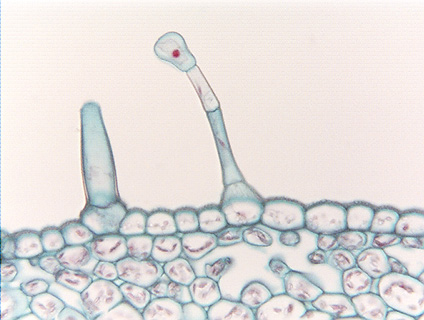 Fig.
9.4-1. Transverse section of stem of foxglove (Digitalis purpurea).
You will see this type of secretory structure on many different species; it is
extremely common. It is a glandular
trichome (less formally called a glandular hair) that consists of a
stalk that supports the secretory head. The stalk may be short – as shown here
– or longer, and the head may be just a single cell or a group of several
cells. The secretory product may simply accumulate inside the central vacuole of
the secretory cells, or it may instead accumulate between the cell wall and the
cuticle (the cuticle here is too thin to see).
Fig.
9.4-1. Transverse section of stem of foxglove (Digitalis purpurea).
You will see this type of secretory structure on many different species; it is
extremely common. It is a glandular
trichome (less formally called a glandular hair) that consists of a
stalk that supports the secretory head. The stalk may be short – as shown here
– or longer, and the head may be just a single cell or a group of several
cells. The secretory product may simply accumulate inside the central vacuole of
the secretory cells, or it may instead accumulate between the cell wall and the
cuticle (the cuticle here is too thin to see).
The trichome on the left has no secretory head. Look carefully at its tip and notice that it looks diffuse, indistinct whereas the side walls are cut cleanly. The trichome was not lying parallel to the plane of sectioning, so the microtome knife cut it at an angle. At the time of sectioning, the left trichome might have had a secretory head just like the right one. Or it might have been a little older and have abscised its head once it had finished secreting (see Fig. 10.33 on page 191 in Plant Anatomy (Mauseth)). Another possibility is that the left trichome is a completely different type from the right one: many plants with secretory trichomes also have non-glandular ones as well.